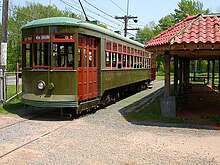Connecticut Trolley Museum
This article includes a list of references, related reading or external links, but its sources remain unclear because it lacks inline citations. (January 2017) |
 A New Orleans streetcar stops at the Isle of Safety (originally at State St, Hartford) | |
 | |
| Established | 1940 |
|---|---|
| Location | 58 North Road East Windsor, Connecticut |
| Type | Railroad museum |
| Website | ct-trolley.org |
Coordinates: 41°55′53″N 72°35′41″W / 41.93139°N 72.59472°WThe Connecticut Trolley Museum, founded in October 1940, is the oldest incorporated museum dedicated to electric railroading in the United States.[1] The museum is located in East Windsor, Connecticut and is open to the public April through December. The museum features static and moving displays, and self-guided tours of the state's trolley history.
Also located on the same property is the Connecticut Fire Museum which exhibits antique fire apparatus and motor coaches.
Heritage Railroad[]
The museum operates a 1.5 mile (2.4 km) heritage railroad over the original right-of-way of the Hartford and Springfield Street Railway Company's Rockville Branch. The Rockville Branch started at the Main Fish Market, and ran 17.5 miles (28.2 km) to Rockville, Connecticut. The branch line saw factory workers, tourists, and high school students. The interurban cars were more direct, and could hold more people than the few buses of the time. The line also serviced Piney Ridge, an amusement park located just between Broad Brook and East Windsor. Most trolley companies built parks — like Piney Ridge — to create revenue on the one day no one went to work, Sunday. Piney Ridge featured a large pipe organ, a dance floor on trolley springs, and a baseball field. The dance floor with trolley springs allowed people to ease their knees as they danced the night away. The baseball field hosted games to two major players, Babe Ruth, and Lou Gehrig. Unfortunately when the Hartford and Springfield faced financial debts, the company went out of business. Their streetcars were brought to Piney Ridge and scrapped. By 1926, the track was gone, and the Rockville Branch with it.
It would be 14 years until the Connecticut Electric Railway Association was formed and began restoring service on the line. Unlimited rides on cars are included in the admission for the day. A minimum of two different cars are run each day. Many times up to three or four cars will be rotated through during the day, giving visitors an opportunity to experience many different types of streetcars and interurbans.
Collection[]


The museum has a diverse collection of equipment to help tell the story of the trolley era and its impact on society. Most of the equipment is stored in one of four car barns, the Visitor Center, or the car shop. Although, there exists an outdoor storage track that is next to the car shop, it goes quite far into the woods.
The Connecticut Trolley Museum has one or more of the following cars operating for the public when the museum is open:
- Montreal Tramways sightseeing car 4
- combine car 16
- New Orleans Public Service closed car 836
- open air car 355
- Boston Elevated Railway Type 5 car 5645
- Connecticut Company closed car 1326
In addition, the museum is currently working on the following cars in the restoration shop:[2]
- Connecticut Company Birney Safety car (double truck) 3001
- Nassau (New York) Electric Railway car 169
- Oshawa Railway steeplecab 18
- Iowa Southern Utilities Co. line car 1
- Northern Ohio Traction & Light Co executive car 1500
- Boston Elevated Railway PCC 3100
- New Jersey Transit PCC 15 (Cosmetic restoration)
The Main Hall of the Visitor Center is set up with an exhibit detailing the progression of the era and its impact on society. The following cars are on display in the Visitor Center:
- parlor car 1500
- Illinois Terminal PCC 451
- Springfield Electric Railway combine car 10
- car 36
- Ponemah Mills Locomotive 1386
- Shaker Heights Rapid Transit car 1201
- Montreal Tramways car 2056
- Fair Haven and Westville car 154
- For a full list of the collection, go to their website here.
References[]
- ^ "Connecticut Electric Railway Association". www.ct-trolley.org. Retrieved 2021-09-04.
- ^ Buffum, Kelly. "Lusa Car Shop Blog". Connecticut Trolley Museum Car Shop Blog.
External links[]
| Wikimedia Commons has media related to Connecticut Trolley Museum. |
- Connecticut Trolley Museum Website
- Connecticut Fire Museum, with photographs of the collections
- CT Trolley Museum "Lusa Car Shop Blog"
- Museums established in 1940
- Railroad museums in Connecticut
- Museums in Hartford County, Connecticut
- Heritage railroads in Connecticut
- East Windsor, Connecticut
- Streetcars in Connecticut
- Street railway museums in the United States
